
KORCA
The City of Serenades!
Korça Promenade
The Korça Promenade is the heart of the city, and a central point which combines a rich history with its most contemporary architectural, and recreational offerings. The Korça Promenade is the main walkway of this beautiful city. Lined with trees, traditional houses, modern cafes and restaurants, the street is a real magnet for local and international tourists. However, Korça is not particularly known as a touristic town. On the contrary, it is precisely the vibrant local life and atmosphere that gives the town its particular authentic appeal.
A walk along the famous promenade will acquaint you with Korça’s contemporary life as well as its significant history. At the Promenade’s entrance stands the iconic sculpture, the “Unknown Soldier,” crafted by the renowned Albanian sculptor Odhise Paskali in 1933. The monument commemorates the city’s patriots who fought against foreign invaders. Behind it, the new Orthodox Cathedral Christ’s Resurrection, built in the last few decades, has swiftly become one of the country’s must-see architectural structures.
As you make your way to the other end of the promenade, you will find the Panoramic (or Red) Tower in the centre of the square. Here, you can take the stairs or the elevator to climb the height of 33 metres and enjoy beautiful panoramas of the entire town. The promenade boasts most of the best restaurants, bars, cafes, and guesthouses in the city. One of the best places to have your morning coffee, lunch, afternoon glass of wine, or even spend the night is Vila Themistokli. It’s warm, contemporary yet traditional atmosphere, and the beautiful veranda surrounded by trees and flowers, make it a wonderfully pleasant place to relax.


Museum of the First Albanian School
A requisite stop in Korça is the Museum of the First Albanian School. Located across “Unknown Soldier,” its yard is decorated by the ABC obelisk, the museum’s symbol. Opened in March 7th, 1887, this first secular school in the country is locally known as “Mësonjtorja.” Here, the visitor can find copies of the original Albanian ABC-books as well as a model of a traditional classroom. It contains the history of Albanian writing and Albanian publications, such as the first Albanian alphabet written by patriot Naum Veqilharxhi and the second Albanian alphabet written by Kostandin Kristoforidhi.
There are also pictures and photos of prominent patriots who contributed to the opening of the school, such as Pandeli Sotiri, Petro Nini Luarasi and Nuçi Naçi. The building itself dates back to the 1840s, the house retains many of its original features and today it holds the status as "Monument of Culture" in Albania. Since the time of its construction, the building has been mostly in public function towards the society.
The building was the home of the patriot of Korçë, Diamanti Tërpo, who donated the building to the Albanian school. From 1887 to 1902 there was "Mësonjëtorja", where it was later administered by Ottoman authorities, which used the building as a prison until the Young Turk Revolution, where local Albanians took over again the administration of the building, to reopen the Albanian school and to set up the musical and patriotic band called "Banda e Lirisë" in 1 October 1908. As a school, the building continued until 1967, the year when it was given the function as a museum space with the name of National Museum of Education, as well as still called today.
The office room serves as a separate pavilion and there it is also placed the "Libri i Vizitorëve" (transl. Visitors Book) where visitors and tourists can leave their notes on their impressions to the museum. In the museum there are exhibited two of the firstest editions of the Albanian alphabet (in 1844 and 1845), published by Naum Haxhi Llazar Bredhi or more commonly known as Naum Veqilharxhi. These alphabets were distributed in Southern Albania, especially in the Korçë and Përmet areas.

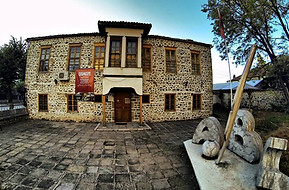

National Museum of Medieval Art, Korçë
The National Museum of Medieval Art is an Albanian national museum dedicated to medieval art and history in Korçë, Albania. The museum is located on Fan Noli Boulevard in the south-east of the city of Korça. It was established on April 24, 1980 and the building was reconstructed on October 04, 2016 with the cooperation of the city municipality and the Greek Government fund.
The museum has over 7,000 art and cultural items, mainly icons, stone, wooden, metal and textile work representing various moments in Albania's iconography development. In the principal hall there are many works from anonymous artists of the 13th-14th century and well-known ones including Onufri, Onufër Qiprioti, Teacher Kostandini, Jeromak Shpataraku, David Selenica, and the Zografi Brothers.
This, the newest museum in the country, preserves some artworks which have miraculously survived countless obstacles of the communist regime, to help them be where they are today. Its interior is separated into halls of varying colours, which serve as stunning backdrops to the hundreds-of-centuries-old objects adorning its walls. The Golden Wall, which covers two floors with its 9.5 metre height, exhibits the impressive 16th-century collections whose sheer volume is astounding. This is followed by the White Balcony, where the oldest icons of the Museum, those of the 14th century, are exhibited.
Here, you will find one exceedingly rare and symbolically significant icon from the Church of Saint Mary, which features St. Michael (Shën Mëhill), who in one hand holds the globe with Christ’s initials engraved in it and, in the other hand, a sword. The Black Labyrinth Pavilion exhibits the works of the famed Albanian artist Onufri, whose signature bright, fiery red is especially radiant against the ominous background. This labyrinth is a corridor that particularly facilitates the special attention required of the twenty icons of the 16th and 18th centuries displayed here. The Red Room, in the centre of which is located the 18th century iconostasis with carvings of apocalyptic motifs, is one of the most exhilarating and warm environments of the Museum.


"Resurrection of Christ" Albanian Orthodox Cathedral
The Resurrection of Christ Cathedral of Korçë is the main Albanian Orthodox church in Korçë, Albania. The cathedral was built by Greece in 1995. A previous cathedral in Korçë named after St. George was destroyed by the Communist authorities in 1968. It is painted in pink, blue and brown. Inside, the modest white interior is dominated by a huge carved wooden iconostasis.

Mirahori Mosque and Clock Tower, Korçë
Iljaz Mirahori Mosque, Xhamia e Iljaz Mirahorit is a historic mosque in Korçë, Albania. It was built in 1494 and finished in 1496 by Iljaz Hoxha, also known as Iljaz Bey Mirahori, who was a veteran of the Istanbul Conquest and the city-founder of Korçë. on the foundations of an existing church, then called dedicated to Saint Paraskevi, Kisha e Shën e Premtes. With its minaret being torn down during the Communist dictatorship, the Iliaz Mirahor mosque was declared a religious Cultural Monument of Albania. After the end of Communist rule in the 1990s, the minaret was rebuilt in 2014.
The Ottoman Clock Tower of Korçë in front of the mosque was also rebuilt. The Clock Tower of Korçë is a historic Ottoman Turkish clock tower dating from the 18th century and recently reconstructed. It is situated in the Old Bazaar of Korçë, Albania. The clock tower was built in 1784 after an agreement between Muslim Albanians and Orthodox Moscolopans and was part of the Mosque Complex of Iliaz Hodja built in 1490. The tower was made of stone and had a typical Ottoman style. It was destroyed during the communist dictatorship of Enver Hoxha due to an earthquake on May 21, 1960.

Archaeological Museum, Korça
Housed in the guesthouse of a larger mansion dating from 1870, this interesting (though itself fairly antique) museum has an excellent collection. Highlights include numerous artefacts found at the prehistoric sites of Maliq, Podgorica, Dunaveci and Trajan, as well as two skeletons from the tumulus of Kamenica, an Illyrian burial site dating from the Bronze Age where some 440 skeletons have been recovered.

Old Bazaar of Korçë
Established about 500 years ago, it is composed of old Ottoman and Roman architectonic style buildings which for centuries were used as shops, guesthouses or khans. It is said to be noted for selling goats and handbags. It was mostly rebuilt in 1879 following an extensive fire The old bazaar comprises 138 first category culture monuments. It is also called as the Bazaar of the Serenades, associated with the music which for centuries was composed and sung by people whilst walking with a guitar on the round cobblestone.
The bazaar of Korca was one of the most reputed of the ottoman times in Albania. Indeed, the relevance of korca as market and traders place started only after the decadence of the neighbour city of Voskopoje, but the bazaar became well known, mainly for quality of clothes, the variety of spices and the animals sold there (goats mainly). apparently it was a noisy busy place and very soon took the nickname of bazaar of serenates.
Today it is a big market which keeps - around a big square-also some old streets filled with small shops pretty much similar to eastern bazaars. In a parallel alley there is also a large food market occupying a long street and two big covered naves. all the area is bustling and colourful. Walking in the part of food supplies it is surprising the richness of spices: chillies, salep, chamomile, herbal teas. There are on sale several kinds of mountain honey.
Also, the reputed fasule, big beans traditional from the region. One of the sweetest corners in the bazaar are the two-remaining caravansary. They are called han in Albanian and keep all the atmosphere of old times. The one is called Han Manastir. It has a small garden in the middle of the courtyard, with some old funerary steles and the remaining of an old gates. The upper side is used as stores for shops. In the down some shops of clothes and cleaning products and a beautiful coffee shop. Korca was always a crossroad. It must be so taken into consideration where is the city, and its history which passes over the current borders. A cosmopolitan air makes more fascinating the city and the market. In the entire bazaar it is easy to see posters and writes in Greek and to listen people speaking in Macedonian language.



Holy Resurrection Church, Mborje
One of the oldest churches in the Balkans, it has several possible construction dates. One tradition holds that it was built in 896 in honour of Pope Clement I, while another attests to construction in the 14th century. The church lies at the foot of Mount Morava just southeast of Korçë, and features anonymous frescoes dating to 1390. On the 40th Day after death each year, pilgrims of the Orthodox Church of Albania flock to the church.
At the time it was built, the church was under the rule of the Lordship of Berat, dominated by the Muzaka family of feudal lords. A bishop named Nimfoni collected funds for construction from 1389 to 1390. A striking if small edifice, it belongs to a group of churches with an engraved cross lacking internal reinforcement. A central square cella topped with a dome forms the center, connected by two open gates (one to the south and one to the west) with the portico. The church is only 7.5 metres (25 ft) at its highest.

Guri i Cjapit
Guri i Cjapit is located inside the Bozdovec Park, in the Drenovo commune of the Korça district. Represents a conglomerate and sandstone rock block with special shape; resembles a camel sitting on the ground. It got its name from a goat that fell on this rock. The length of this stone is 20-25 meters, the width is 5-10 meters, and almost the same height. It consists of conglomerate rocks modeled by erosion and wind. It has scientific and tourist values.
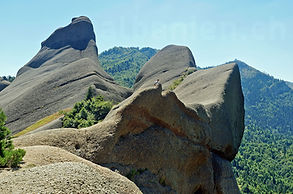
Morava Mountain
At 2042 metres high, Badarosh Peak is an impressive sight. The rare natural beauty combined with the wonderfully fresh climate of the area, makes this mountain a very worthwhile experience. When Albanians think of Morava, their minds spontaneously turn to its famously delicious honey. A visit to Morava includes an obligatory stop at the charming bee farm, located at the foot of the mountain. Open to all visitors, here they can intimately experience all stages of the honey-making process, as told by the most famous honey-makers in the land. Morava is a place of cultural heritage and tradition.
A big white cross, Morava’s symbol, is located at the edge of a cliff here. It serves as a guide for believers, and a landmark for mountain climbers. Near the Cross, you’ll find the superjacent Church of St. Elias with its breath-taking view of the horizon. In addition to its spiritual draw, the mountain’s beautiful nature has made it a popular destination throughout the year. This place is like no other when it comes to relaxing picnics and other recreational outdoor activities. Morava is a favourite destination for more adventurous sports, as well. In winter, countless alpinists climb the snow-covered Rrugnaja Peak.

Fir of Drenovë National Park
The Fir of Drenovë National Park is a national park near Korçë in eastern Albania, with an area of 10.3 square kilometres. The park falls within the Illyrian deciduous forests and Dinaric Alpine mixed forests terrestrial ecoregion of the Palearctic Temperate broadleaf and mixed forest, dominated by the Silver fir. The diverse morphological, climatic and hydrological conditions of the region favour the formation of a large number of geological features. The national park is host to many rock formations such as the Stone of Capi, the Cut stone, the Zhombrit’s Pyramid, Cave of Tren but also many water features such as the Lenies Lakes, and the Karstic Cavity. All these are under protections and declared as natural landmarks by the Government of Albania.
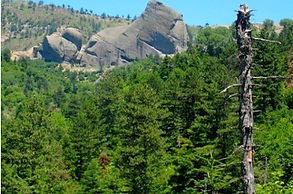
Voskopoja
Nature meets art and history in Voskopoja, making it a favourite destination for tourists year-round. The town of Voskopoja is renowned for having been a cultural centre since 1330 and, over the centuries, more than 24 churches were built there. The city hosted the first printing press outside Istanbul along other important institutions, such as the New Academy.
Unfortunately, many of these buildings were eventually destroyed by fires, wars, robberies or earthquakes. From that glorious past, now the visitor may admire The Monastery of St. John the Baptist, Manastiri i Shën Prodhromit, the Church of St. Mary, Kisha e Shën Marisë, the Church of Saint Athanasius, Kisha e Shën Athanasit, the Church of Saint Nicholas (Kisha e Shën Kollit), among other churches or buildings which are now considered culturally, historically or aesthetically significant.
Located only 21 km, 13 miles away from Korça, Voskopoja is surrounded by hills and forests and, with its altitude of 1160 meters above the sea, this area is a favourite spot for winter sports such as skiing and snowboarding. Here, you’ll find hotels of the highest standards and traditional restaurants which serve the famous cuisine of the region, all making your stay unforgettable.


St. Nicholas Church, Moscopole
St. Nicholas Church, is an Orthodox church in Moscopole, Albania. The church was erected in 1721. It is a Cultural Monument of Albania since 1948. The church was built in 1721. The structure consists of a basilica-type construction Struktura with a naoscovered with a cupola, a narthex and a cloister.
The interiors of the church are decorated with mural paintings executed by David Selenica and his helpers Kostandin and Kristo. The art of Selenicasi is distinguished by its realistic nature, as it is witnessed by the portrait of the donor, as well as by a deep theological knowledge. According to the inscription, the portrait of the donor the painting was finished in 1726 and this was determined by an archaeologic expedition in 1953. 24 years later, in 1750, the Zografi Brothers painted the cloister.

St. John the Baptist's Monastery, Korca
St. John the Baptist's Monastery, Manastiri i Shën Prodhromit, is an Orthodox monastery in Moscopole, Albania. According to the donor's inscription, the church inside the Monastery was built in 1632 and painted in 1659. Today the monastery is declared a Cultural Monument of Albania. The monastery includes the church as well as two other buildings which were part of the monastery. The church has dimensions of 17m x 7.65 X 9m. The frescoes are preserved and in a good afresket and worked with components of iron and calcium. The church is characterized by decoration on a particular type of tile that is found in the area.

Dardha
At a height of 1344 meters, this ultra-cosy 300-year-old southern touristic village with unforgettable panoramas and delicious food is the place to spend your fantasy winter weekend. Not only winter, but all seasons of the year are perfectly manifested in Dardha, thanks to its lucky position among mountains and forests.
Yet, in the winter, Dardha may be one of the most surprisingly perfect touristic villages in Albania. Snow-covered traditional houses, some of the best traditional foods in the country, a kind of freshness that fills your lungs with air and makes you feel totally rejuvenated. These, among plenty of other aspects, have tourists rushing to this wonderfully regenerative destination.
The name Dardha, meaning “pear” in Albanian, refers to a wild pear tree that became a landmark of the area. When people first asked the initial residents of the village where they lived, they would always answer “near the pear tree,” and, thus, the name was born. The village was established 300 years ago from “rebels” who refused to convert to Islam during the Ottoman Empire. Not coincidentally, it is this exact sense of freedom that you feel while being immersed in the perfect colours of Dardha’s landscape and nature.
While during the winter Dardha is covered in white, the three remaining seasons also display such a rich variety of colours that you instantly realize why so many important Albanian painters and artists hail from this place. From the renowned Zengo family, to Kostandin Zografi and author Teodor Laço, this village has profoundly influenced the cultural Albanian landscape.


Prespa National Park
The Prespa National Park, one of the largest national parks in Albania, situated in south-eastern Albania on the border triangle shared with Greece and North Macedonia. At approximately 277.5 square kilometres, the park encompasses the country’s sections of the Great and Small Prespa Lake. It is considerably characterised by high mountains, narrow islands, vast freshwater wetlands, salt marshes, meadows, reed beds and dense forests.
Established to protect the natural and cultural heritage of the region, the park is included in the European Green Belt and the World Network of Biosphere Reserves under the UNESCO Man and Biosphere Programme. Albania’s section of Great Prespa is recognised as a wetland of international importance by designation under the Ramsar Convention and further as an Important Bird and Plant Area. Both lakes are essentially situated between 850 and 900 metres elevation above the Adriatic.
Located about 150 metres above Lake Ohrid, their waters pass through several karst underground channels emerging from springs into the lake. Mali I Thatë separates the Great Prespa from Lake Ohrid, which is one of the most ancient lakes in the world. The region therefore is particularly well-known for its fresh waters and sandy beaches.

Pogradec
Pogradec is a tranquil, historical, and cultural city. It’s the perfect destination for romantic souls, having inspired generations of artists with its surrounding natural beauty. Pogradec, the city of artists, resting on the shores of Lake Ohrid, is certainly one of these. It’s an ideal place for the romantic soul, who seeks and relishes nature’s peace and tranquillity.
One of Albania’s most revered national poets, Lasgush Poradeci, sang odes to Lake Ohrid in many of his works: “Upon the road of autumn’s forest, sleeps the endless lake”. Similar to the famous Romantics, Wordsworth, Byron, and Keats, Poradeci’s verse was inspired and sustained by the great natural beauty that surrounded him. The city of Pogradec lies on the western shore of Lake Ohrid, which is the heart and soul of this city. Poradeci was not the only one who recognised the value of this beautiful lake. In 1980, UNESCO proclaimed it a Natural Heritage Site, and from 2019 the Albanian part was inscribed in the list as well.
Ohrid is the deepest (285m) lake in the Balkans and is split between Macedonia and Albania. It took around 4 million years for this lake to form its present shape, from the moment the soil began to shift on the western side of the Dinaric Alps. Now, it is a veritable, picture-perfect swan lake, as well as an ecosystem that includes over 200 species. With an enviable and quite extraordinary three hundred sunny days per year, and warm climate, Pogradec is a prime destination for thousands of Albanian and foreign tourists.
While there’s a multitude of fine gastronomic traditions, the world-famous delicacy in Pogradec is a golden-skinned, salmon-coloured fish called Koran (also known as the Ohrid trout), found only in Lake Ohrid. Any waiter in the area will be proud to tell you the famous story, of how Koran even travelled to Buckingham Palace at the request of Queen Elizabeth II, who became such a fan of this unique fish that she had it imported to her residence. Let us not forget that the Albanian trifecta includes not only natural beauty and delicious foods, but a rich history as well. The Castle of Pogradec is not to be missed, as its ruins retain the six-thousand year history of the city, and the Illyrian tribes of the Encheleans and Dassareti who established it. At its highest point, it stands 205 metres, 673 ft above Lake Ohrid.
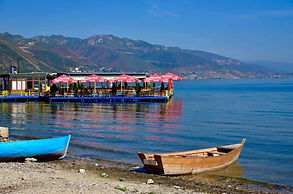

National Park of Drilon
Drilon is such a peaceful place surrounded by nature in every corner. Take your time to relax, to go on a boat ride and to eat some delicious meals. The fresh springs that colour the scenery green create a place resembling paradise. The area is also inhabits species of birds with many of then residing by the river.
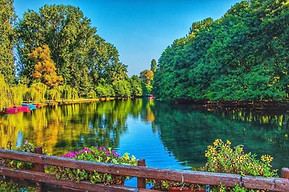

Maligrad
The tiny island of Mali Grad tells a story of art, religion and the geological evolution of Lake Great Prespa. Located near the village of Pustec (Liqunas), it's a fantastic place to watch some of Prespa’s famous fauna in undisturbed tranquillity. Maligrad island is situated deep within the Albanian part of Lake Prespa, with many caves suitable for wildlife and a circular cliff. Shaped like a tadpole, it contains some trees and an area of sand.
The island contains a famous Saint Mary Church, built by Kesar Novak, a local noble, in 1369. It has an area of almost 5 hectares. The St. Mary's Church or Virgin Mary's Church, Shpella e Maligradit is an Eastern Orthodox cave church on the island. It is a Cultural Monument of Albania. The church is dedicated to Saint Mary and was built by Serbian nobleman Kesar Novak, Qesar Novaku, in 1369. The church has frescoes and Greek inscriptions dated to 1369. Frescoes exist of the family of Novak, with his Greek wife Kalia.

Lin
The village of Lin appears below, as you drive down the national road that leads to Pogradec. This small peninsula softly joins the shores of Lake Ohrid. It was once called “Lake of Light” perhaps because the light of both the sun and the moon wholly illuminate its surface year-round. Indeed, this lake’s reflections are legendary. Hundreds of locals reside in this small but beautiful peninsula. As you descend the road to get there, you will notice the beautiful red roofs of its characteristic small homes. One of the oldest mosaics in the eastern European region, dating back to the 4th century, is found here.
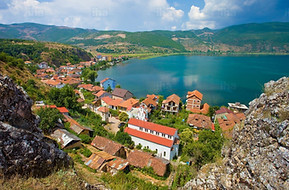
Liqeni i Gramozit
The village of Lin appears below, as you drive down the national road that leads to Pogradec. This small peninsula softly joins the shores of Lake Ohrid. It was once called “Lake of Light” perhaps because the light of both the sun and the moon wholly illuminate its surface year-round. Indeed, this lake’s reflections are legendary.
Hundreds of locals reside in this small but beautiful peninsula. As you descend the road to get there, you will notice the beautiful red roofs of its characteristic small homes. One of the oldest mosaics in the eastern European region, dating back to the 4th century, is found here.




